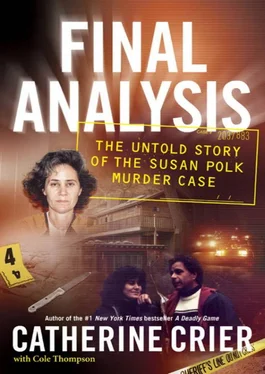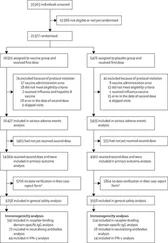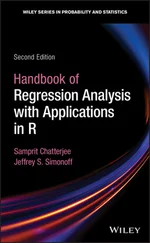Outside the courtroom, Horowitz’s cocounsel, Ivan Golde, pointed to “a whole host of conflicts” that could arise since the same police agency that investigated Felix Polk’s murder was now looking into the death of Dan’s wife.
“You’ve got the same pathologist doing both investigations,” Golde told journalists gathered at the courthouse that Monday. “This creates a huge conflict. I don’t even know if we can try both cases now in Contra Costa County. We were doing well in there,” Golde said optimistically of their first week in court. “We were winning this case. I hope we can pick up where we left off.”
Still, members of the Polk jury said they did not hear enough of the case to form an opinion as to Susan’s guilt or innocence. “The prosecution was the only one who had the chance to present information,” said juror Mark Zigler of Concord. “There was not any reason to dismiss anything.”
Pamela Vitale had been seated in the front row of the courtroom on October 11, when her husband delivered his opening remarks in the high-profile Polk murder case. Now, just seven days later, her battered corpse lay on a gurney in the coroner’s office, awaiting an autopsy by Brian Peterson, the pathologist who performed the autopsy on Felix. Horowitz was not pleased to learn that Peterson was going to conduct the post mortem examination of his wife, since he had intended to dispute several of his findings at trial.
It was just after 10 AM on October 17 when the medical examiner removed a large gold and diamond ring from Pamela Vitale’s left ring finger, and a gold band with a dark-colored stone and multiple clear stones from her right ring finger. After placing the items in the office for safekeeping, Dr. Peterson began the two-and-a-half-hour post mortem examination on Vitale.
In his official report, Peterson listed the cause of death as “blunt force head injury.” Pamela Vitale had sustained at least twenty-six crushing blows to the head and thirteen more to other parts of her face and body. “There are extensive scalp lacerations and abrasions,” Dr. Peterson recorded. “On the right side of the scalp, at least 8 distinct injuries are identified…”
An examination of the victim’s torso revealed a post-mortem four-inch stab wound to the left upper abdomen that had perforated the stomach, exposing the intestines. There was also “an H-shaped figure” carved into the skin of the “posterior torso area.” Scratch marks on Vitale’s breasts, arms, legs, and body indicated she had fought very hard for her life that morning. There were no signs of sexual assault. Still, a rape test was performed with negative results.
That Monday afternoon, police released an affidavit revealing that Pamela Vitale was not only bludgeoned but also savagely stabbed by a killer who wore gloves. In addition, crime scene investigators had located a “large-sized blood shoeprint” on the cover of a storage container found at the crime scene.
Two days after the autopsy, police made an arrest in Pamela’s murder. Surprising to some, the accused seemed to have no connection to the Polk case. The alleged killer was a sixteen-year-old boy named Scott Dyleski who lived with his mother and two families—eleven people in all—in a ramshackle house about one mile from Dan and Pamela on Hunsaker Canyon Road. Investigators linked Dyleski to a scheme with another youth to buy equipment for growing marijuana with stolen credit cards. The fraudulently obtained equipment was to be shipped to Dyleski’s address but listed Vitale’s home as the billing address. Homicide detectives speculated that Dyleski had gotten into a confrontation with Vitale when he went to her house thinking the package may have been accidentally delivered there.
Homicide detectives zeroed in on the teen just two days into their investigation after receiving a tip from a neighbor claiming that someone had obtained a credit card under his name and used it to purchase equipment often used to grow marijuana. In recent months, several of Vitale’s neighbors on Hunsaker Canyon Road had reported mail being stolen from a common mailbox area along the road at the base of a hill. An investigation into the thefts had yielded no suspects until one resident, Doug Schneider, reported that Horowitz’s remote hilltop address was provided as the shipping address for the hydroponics equipment that had been charged to his credit card on October 12.
Police got a second break on October 19 when a youth came forward to confess to a marijuana-growing scheme with his former classmate, Scott Dyleski. The youth, Robin Croen, told police they had been using fraudulently obtained credit cards to purchase the hydroponics lights used for growing marijuana. Croen, a student at Acalanes High School in Lafayette, told police that he and Dyleski, a classmate, intended to grow the plants in Dyleski’s closet.
According to Croen, the night before the murder Dyleski claimed that “there was some sort of problem with the orders” and assured him that he “just needed some more time to do something.” Police later learned that Dyleski and Croen, who was not implicated in the murder, allegedly conspired together in the mail thefts—including the one that lead to Vitale’s death.
Croen also told police that Dyleski had scratches on his face when he saw him on October 15—the day of the murder. Three days later, Dyleski showed up at Acalanes High School during lunch period and announced that he was going to tell his housemates about the credit card scam. “He said he was going to admit it because somehow this would separate him from the [Vitale] murder,” Croen told authorities. The comment concerned Croen, who could not understand how their credit card scheme could be linked to the woman’s murder. He asked Dyleski what he was talking about, and Dyleski “said he was afraid his DNA was on her because she had grabbed him at some point (while he was walking in the woods). I asked how or why, but I didn’t get an answer,” the youth told police.
Police subsequently alleged that Dyleski went to Vitale’s home that Saturday, October 15, to pick up the marijuana-growing equipment he ordered, but the package was not in the mailbox. Investigators suspected that Dyleski went inside the trailer to find out what happened to it, where he confronted Pamela Vitale and beat her to death. Dyleski had no way of knowing that the hydroponics equipment had never been shipped because the supplier suspected that something was amiss.
According to detectives, the gangly 5′5″, 110-pound teenager was wearing gloves and a Balaclava mask (a mask which covers the entire face, with slits only for the eyes) when he entered the trailer home. Evidence collected at the scene indicated that he struck Vitale more than thirty times about the face and body with a broken piece of crown molding and other items before carving a “gothic signature” in the shape of an “H” into the small of her back.
After the murder, Scott Dyleski allegedly poured himself a glass of water, rinsed his hands in the sink and had a shower: a forensic examination of the bathroom faucets revealed traces of blood. Apparently unconcerned about the blood-stained crown molding he left, the teen used a little-traveled trail through the woods, arriving home sometime between 10:20 and 11:00 that morning. Croen wasn’t the only one who noticed Dyleski’s injuries that day. Several of his housemates later told police that they observed a gash on the boy’s face that morning. When asked about the wound, Scott claimed he scratched himself during a morning hike in the woods.
A forensic examination of Vitale’s laptop showed Pamela was on her computer, surfing the Internet for various things, including Court TV’s website, for articles about Dan’s criminal representation of Susan Polk, when Dyleski entered the trailer that Saturday morning. Logs show that at 10:12 AM her computer searches ceased.
Читать дальше











